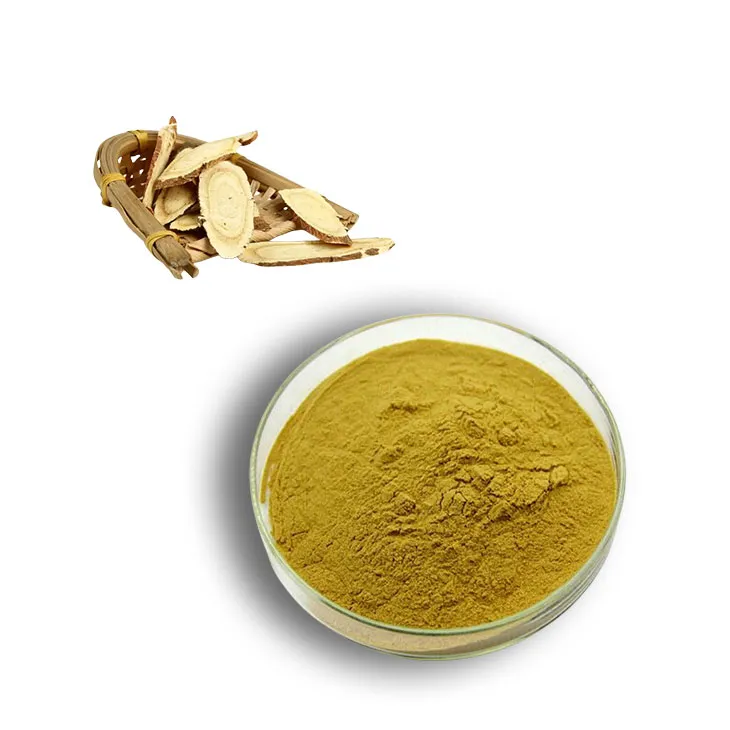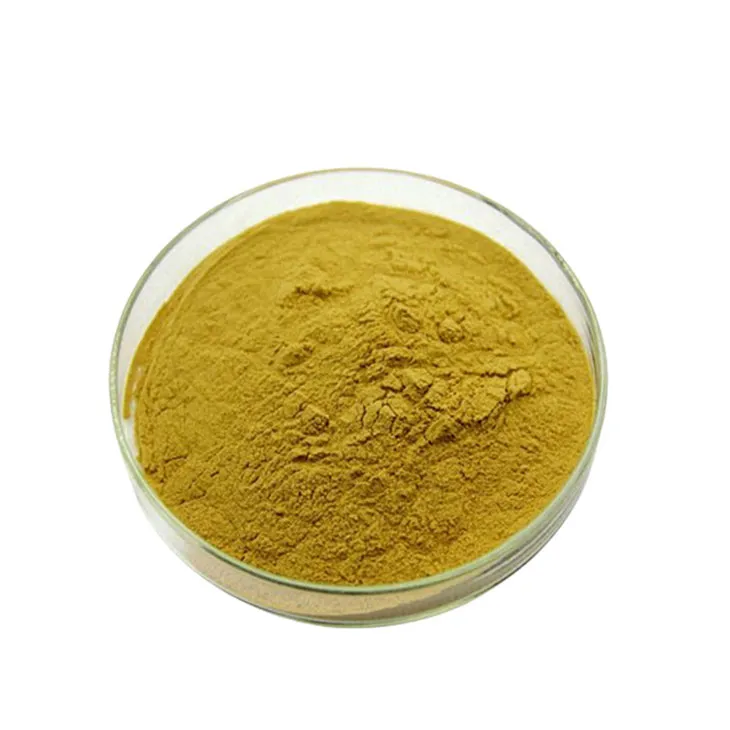- 0086-571-85302990
- sales@greenskybio.com
Read our comprehensive primer on high - quality organic licorice root extract powder.
2024-12-15

I. Introduction
Organic Licorice Root Extract Powder has been garnering significant attention in recent years. This powder, derived from the licorice root, is a multi - faceted product with a rich history and a wide range of applications. It is not only a staple in traditional medicine systems but also finding its way into modern wellness and flavor industries.

II. Sourcing of Licorice Root
A. Geographic Origins
Licorice root is sourced from various regions around the world. China, for instance, has been a major producer of licorice for centuries. The vast plains and suitable climatic conditions in certain parts of China provide an ideal environment for licorice root to grow. Additionally, countries in the Middle East such as Iran and Turkey are also known for their licorice production. These regions have their own unique soil compositions and weather patterns that contribute to the growth of licorice root.
B. Organic Certification
Ensuring the organic integrity of the licorice root is crucial. Organic certification involves a series of strict regulations and inspections. The farms that grow licorice root for organic extraction must adhere to practices such as avoiding the use of synthetic pesticides and fertilizers. For example, instead of using chemical pesticides, they may employ natural pest control methods like introducing beneficial insects. Organic farmers also rotate their crops to maintain soil fertility without relying on artificial fertilizers. This not only benefits the licorice root but also the overall ecosystem of the farm.

III. The Extraction Process
A. Harvesting
The first step in the extraction process is harvesting the licorice root. This is typically done at the right time of the year when the root has reached its optimal maturity. Skilled farmers carefully dig up the roots to avoid damaging them. Once harvested, the roots are cleaned to remove any dirt or debris.
B. Drying
After cleaning, the licorice roots are dried. This can be done through natural drying methods such as air - drying in a well - ventilated area or through the use of low - heat drying equipment. Drying is an important step as it helps to preserve the root and prepare it for further processing. It also reduces the moisture content, which is essential for the extraction process.
C. Grinding and Extraction
Once dried, the licorice roots are ground into a fine powder. This powder is then subjected to an extraction process. There are different extraction methods, but one common method is solvent extraction. In this process, a suitable solvent is used to extract the active compounds from the licorice root powder. The solvent is carefully chosen to ensure that it can effectively dissolve the desired components while being safe for consumption. After extraction, the solvent is removed, leaving behind the concentrated Licorice Root Extract Powder.

IV. Diverse Uses
A. In Traditional Medicine
- Digestive Aid: Licorice Root Extract Powder has long been used in traditional medicine as a digestive aid. It can help soothe the stomach and relieve indigestion. For example, in some traditional herbal remedies, it is combined with other herbs to treat stomach ulcers.
- Respiratory Health: It is also beneficial for respiratory health. It can be used to ease coughs and sore throats. In some cultures, a tea made from licorice root extract powder is consumed to relieve bronchial irritation.
- Immune System Support: Licorice root contains compounds that may help boost the immune system. Traditional medicine practitioners may recommend it to patients with weakened immune systems to help them recover more quickly from illnesses.
B. As a Natural Flavor Enhancer
- In the food and beverage industry, licorice root extract powder is used as a natural flavor enhancer. It imparts a unique, sweet, and slightly earthy flavor. For example, it is used in the production of some candies, where it provides a distinct taste that is different from regular sugar - based sweets.
- It is also used in the formulation of herbal teas and some alcoholic beverages. In herbal teas, it adds a pleasant flavor and can complement the other ingredients. In alcoholic beverages, it can add complexity to the flavor profile.

V. Significance in Promoting Overall Well - being
A. Anti - Inflammatory Properties
Licorice root extract powder contains compounds with anti - inflammatory properties. These compounds can help reduce inflammation in the body. For example, in cases of arthritis, where inflammation in the joints is a major problem, licorice root extract powder may potentially offer some relief. It can also be beneficial for skin health, as it may help reduce inflammation associated with skin conditions such as eczema.
B. Hormonal Balance
Some of the components in licorice root extract powder may play a role in hormonal balance. For women, it may help regulate estrogen levels. However, it should be used with caution as excessive consumption may have adverse effects on hormonal balance. In men, it may also have an impact on testosterone levels, although more research is needed in this area.
C. Stress Relief
Licorice root has been associated with stress relief. It may help the body adapt to stress by influencing the adrenal glands. Consuming licorice root extract powder in moderation may contribute to a feeling of relaxation and reduced stress levels. For example, in some traditional relaxation remedies, licorice root is combined with other calming herbs.
VI. Conclusion
High - quality organic licorice root extract powder is a remarkable product with a wide range of benefits. From its careful sourcing to its complex extraction process, and from its traditional medicinal uses to its modern applications in the flavor industry, it has much to offer. However, it is important to use it responsibly, especially when considering its potential effects on health. As more research is conducted, we can expect to uncover even more about the potential of this versatile powder in promoting overall well - being.
FAQ:
What is organic licorice root extract powder?
Organic licorice root extract powder is a product obtained from the licorice root through an extraction process. It is sourced from licorice plants that are grown organically, meaning without the use of synthetic pesticides, fertilizers, or genetically modified organisms. This powder contains various bioactive compounds that give it multiple uses.
How is the licorice root sourced to ensure its organic integrity?
To ensure the organic integrity of licorice root, it is typically sourced from farms that follow strict organic farming standards. These farms use natural methods for pest control, such as introducing beneficial insects. For fertilization, they rely on organic matter like compost. The land also has to be free from synthetic chemical residues for a certain period before the licorice root can be considered organically sourced.
What is the extraction process of licorice root extract powder?
The extraction process of licorice root extract powder usually involves several steps. First, the licorice roots are carefully harvested. Then, they are cleaned and dried. After that, solvents (which are often natural or food - grade) are used to extract the active compounds from the dried roots. The resulting liquid is then further processed, such as through evaporation or filtration, to obtain the powder form of the extract.
What are the traditional medicine uses of organic licorice root extract powder?
In traditional medicine, organic licorice root extract powder has been used for various purposes. It has been known to soothe digestive issues, like reducing inflammation in the stomach and intestines. It has also been used to relieve coughs and sore throats due to its expectorant properties. Additionally, it has been thought to have anti - inflammatory effects in the body and has been used to support the adrenal glands.
How can it be used as a natural flavor enhancer?
Organic licorice root extract powder can be used as a natural flavor enhancer in several ways. It has a sweet and unique flavor profile. In the food industry, it can be added to confectionery items, such as candies and chocolates, to provide a natural sweet taste. It can also be used in beverages, like herbal teas, to add depth of flavor. In some cases, it can be used in savory dishes to add an interesting and subtle flavor note.
Related literature
- The Benefits of Organic Licorice Root Extract in Herbal Medicine"
- "Sourcing and Processing of Organic Licorice Root for High - Quality Extracts"
- "Licorice Root Extract: Traditional Uses and Modern Applications"
- ▶ Hesperidin
- ▶ citrus bioflavonoids
- ▶ plant extract
- ▶ lycopene
- ▶ Diosmin
- ▶ Grape seed extract
- ▶ Sea buckthorn Juice Powder
- ▶ Beetroot powder
- ▶ Hops Extract
- ▶ Artichoke Extract
- ▶ Reishi mushroom extract
- ▶ Astaxanthin
- ▶ Green Tea Extract
- ▶ Curcumin Extract
- ▶ Horse Chestnut Extract
- ▶ Other Problems
- ▶ Boswellia Serrata Extract
- ▶ Resveratrol Extract
- ▶ Marigold Extract
- ▶ Grape Leaf Extract
- ▶ blog3
- ▶ blog4
- ▶ blog5
-
Pure 85% Tomentil Extract.
2024-12-15
-
Curcumin Extract
2024-12-15
-
Astaxanthin
2024-12-15
-
Elderberry Extract
2024-12-15
-
Natural grape seed extract
2024-12-15
-
Cassia Seed Extract
2024-12-15
-
Senna Leaf Extract
2024-12-15
-
Black Garlic Extract
2024-12-15
-
Ginger Extract
2024-12-15
-
Tormentil Extract
2024-12-15
-
Calendula Extract
2024-12-15





















